Bottom Brackets and Bottom Bracket Shells
Bottom Brackets and Bottom Bracket Shells [How-To]
The bottom bracket shell of a bicycle is the part of the frame where the spindle of the cranks go through. The bottom bracket and spindle together form the foundation of the drivetrain on your road bike or mountain bike. All the different standard dimensions can make it hard to determine what kind of bottom bracket shell your frame has and what bottom bracket bearings you need. How can you even tell what bearings and bottom bracket shell your frame has? This extensive how-to explains exactly what you need to do in order to service and replace your bottom bracket bearings yourself.
The bottom bracket bearings are sometimes referred to as just the bottom bracket as well. Whenever we talk about replacing your bottom bracket, we’re referring to the actual bearings that go into the frame. The crank spindle connects the two crank arms and runs through the bottom bracket bearings, which are placed into the bottom bracket shell.

The bottom bracket bearings used to be a single cartridge. The bearings and spindle were all a single component. This is something you no longer see with modern bikes. Most modern bicycles come with the bottom bracket bearings fitted inside or on the sides of the bottom bracket shell. The spindle is attached to one or both crank arms.
Bottom bracket bearings wear out
The bottom bracket bearings are components on your road bike or mountain bike that wear out. Like any other part, they don’t just need regular services but they’ll ultimately have to be replaced as well.

The many different dimensional standards have made it hard to determine what bearings you need once you’ve decided to take on this job. In fact, some of the standards can be interchanged without issues. You’ll require special adapters to do so though. So what bottom bracket bearings fit what bottom bracket shell then?
Replacing your own bottom bracket bearings
This extensive how to on replacing your bottom bracket bearings is divided up into a number of simple steps. We start with taking a look at how you can determine whether your bottom bracket bearings need replacing. After we see how you can determine what bottom bracket shell and bearings you have, and what bearings you’ll need to get to replace them with.
We’ll also have a quick look at the various different bottom bracket converters and bearings. They allow you to combine various different standards.
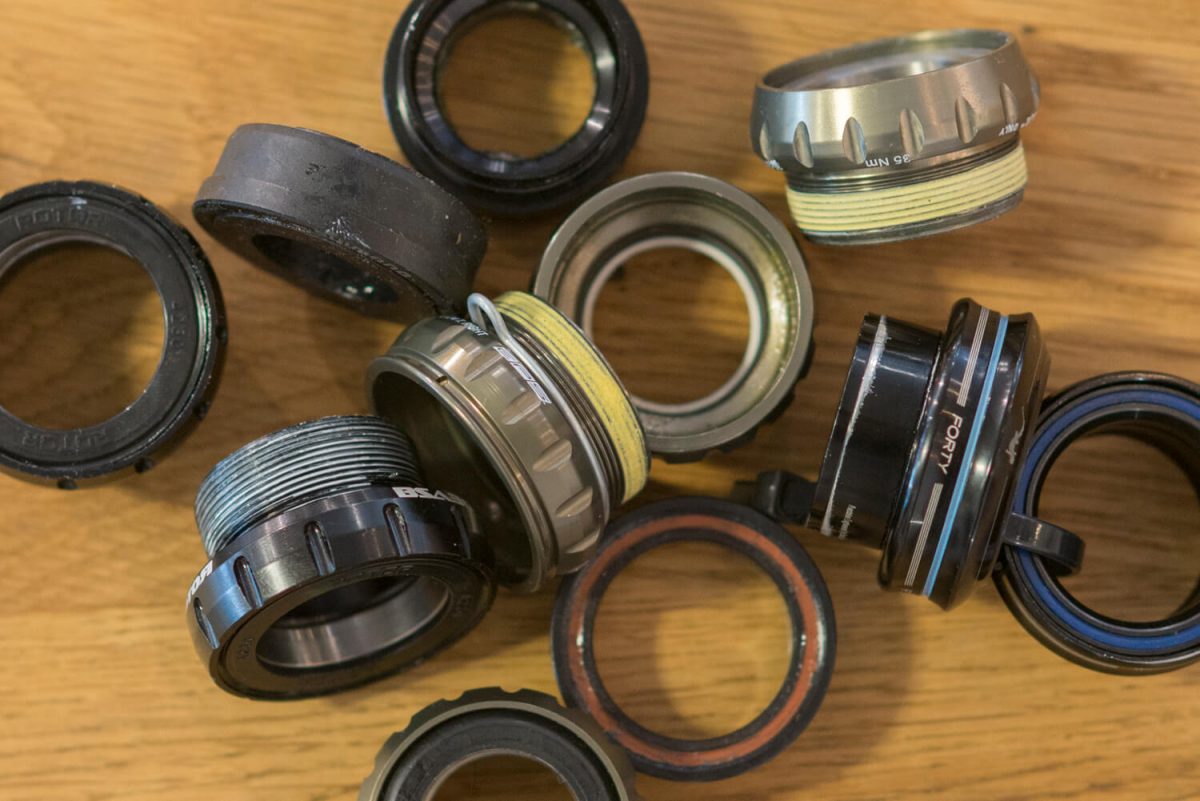
Can’t quite figure it out yet or do you just want to make sure? Contact our customer service, they’ll be happy to help you with any questions you have.
Replacing your bottom bracket bearings
Contents
- When do I need to replace my bottom bracket bearings?
- What type of bottom bracket shell and bearings do I have?
- What bottom bracket bearings go with my bottom bracket shell?
- Converters and adapters for bottom bracket shells, bearings, and cranks
How do I know when to replace my bottom bracket bearings?
You’ll have to replace your bottom bracket bearings once you start noticing things don’t spin quite as smoothly as they used to before. Creaking, squeaking, or play or a rough feeling as you pedal are all indicative of the bottom bracket bearings requiring a thorough check.
It could also be that you want to give your bike a nice upgrade. If you’re swapping groupsets for instance, you’ll remove most of the components and it pays to have a quick look at the bottom bracket while you’re at it.

If you notice they start to wear, you could see whether you could do with just replacing the bottom bracket bearings. You can check by firmly grabbing onto the crank arm and trying to wrench it from side to side. Do you feel or see any play? Then at the very least your bearings will need replacing.
Once you’ve decided to replace or upgrade your bottom bracket bearings it’s time to find out what exactly your road bike or mountain bike has been fitted with. For that, we first take a look at what bottom bracket shell you have in order to determine what bearings you’ll have to fit to them.
What type of bottom bracket shell and bearings do I have?
Identifying your bottom bracket shell can be quite a hassle. Below is a list of bottom brackets and how you can recognise them. It’s a lot easier if you first take the bottom bracket bearings out of the frame.
Both the outside and inside of the shell can have codes on them that make identifying the shell a lot easier. If you have a pair of calipers then you might want to have these at hand as well.
Types of bottom bracket shells
BSA
The BSA and Italian thread bottom bracket shells are predominantly something you find on bikes made before 2010. These two types of bottom brackets are the so-called threaded bottom brackets, which feature a thread on both sides of the shell.
A frame with a BSA fit is incredibly commonplace. There are 4 widths available with BSA bottom brackets; 68mm, 73mm, 83mm or 100mm.
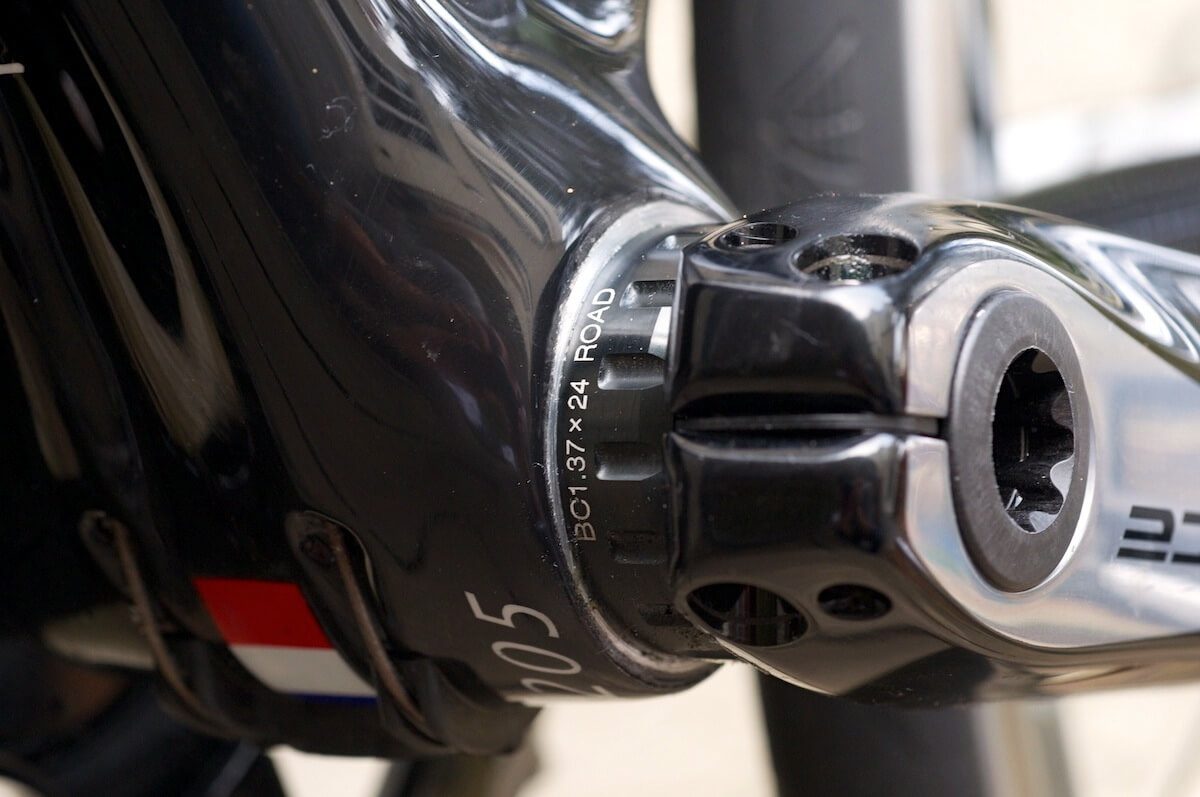
For road bikes, a BSA bottom bracket is always 68 mm wide. Other sizes, and particularly the 73 mm width, is commonplace with mountain bikes. The 83 mm and 100 mm dimensions have become rare these days.
A BSA bottom bracket can also be recognised by the writing on the bracket itself. The bearings denote: 1.37 * 24. This means that the diameter of the thread is 1.37 inch and that it turns 24 times per inch. The diameter of a BSA bracket is between 33.6 and 33.9 mm.
The thread on the left side (non-drive side) is a regular thread. You turn it clockwise to lock it. The right part (drive side) is a reverse thread and has to be done up counter clockwise. A BSA equipped frame can be fitted with almost all types of cranks.
What cranksets fit a BSA Bracket?
- Square axle
- ISIS
- Octalink
- Shimano Hollowtech II
- Sram GXP
- BB30
- FSA Megaexo
- BB386EVO
- Rotor 3D+
- Campagnolo Ultra Torque and Power Torque
ITA
Bottom brackets with an Italian thread (ITA) are far less common than the BSA ones. They’re often found on Italian made bikes. The width is always 70 mm. Furthermore, and this is where it stands out, you always have to do up both sides of the bracket to the right. Thus the name Italian Thread.

The advantage of this unique way of doing up the bottom bracket bearings is that they’re perfectly aligned. The downside is that the right cup is prone to coming undone more easily. This is precisely why you see these bottom brackets less and less on modern bikes.
The most important mark on the bottom bracket is 36 x 24. This means that the diameter of the thread is 36 mm and the thread turns 24 times per inch.
What cranks fit an Italian thread?
- Square axle
- Shimano Hollowtech II
- Sram GXP
- FSA Megaexo
- Campagnolo Ultra Torque and Power Torque
BB30
BB30 bottom brackets have been used frequently since 2006. The spindle always has a diameter of 30mm. This ensures a low weight and lots of stiffness.

The bearings in the bottom bracket shells are pressed directly into the carbon or aluminum of the bottom bracket. This is a precision task though. Even with a slight deviation the cranks won’t turn smoothly. Also a worn out BB30 Bracket easily shows play and starts to make creaking noises. Therefore the BB30 is being used less and less frequently.
The width of a BB30 bottom bracket is 68mm or 73mm. On road bikes, it’s always 68mm. With mountain bikes, 68mm is most common too, but sometimes the wider version with 73mm width can be found.
The diameter of the bottom bracket is 41.96mm, and the bottom bracket bearings are always pressed into the frame separately. If you want to use a Shimano crank, you need an adapter or a bottom bracket bearing which is placed in a special bearing tube. This also prevents creaking sounds. From the outside, you actually barely see the bottom bracket bearings.
Another way to identify a BB30 bottom bracket besides looking at the size is the fact that you don’t see bearing shells because the bearings are pressed into the frame. On most frames with a BB30 Bottom Bracket you’ll also find a sticker with ‘BB30’.
Which cranks fit onto a BB30 bottom bracket?
- Shimano Hollowtech II
- Rotor 3D+
- Sram GXP
- BB30
- FSA Megaexo
- BB386EVO
- Campagnolo Ultra Torque and Power Torque
BB30A
BB30A bottom brackets are exclusively used for Cannondale road bikes. The difference between these and a normal BB30 is the diameter of the bottom bracket, which is 42mm for the BB30A instead of 41.96mm. The width is always 73mm.
Which cranks fit onto a BB30A bottom bracket?
- Shimano Hollowtech II
- Rotor 3D+
- Sram GXP
- BB30
- FSA Megaexo
- BB386EVO
BB86-89.5-92 Press Fit
This is a frequently used standard for both road bikes and mountain bikes. The bearings are not placed directly in the frame, but instead they lie in an aluminium or plastic shell which is pressed into the frame.
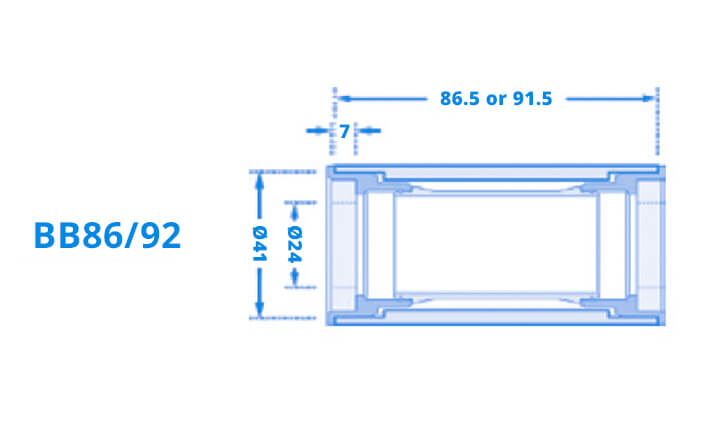
This is a big advantage when it comes to wear and tear. The bearings won’t quickly damage the frame, and the shells balance a little play. The bearings might jam when they’re really worn out, but that won’t happen easily.

As the bearings sit almost entirely inside the frame, the characteristics that you can see from the outside are limited. Only a narrow edge is visible. On a road bike, this bottom bracket always has a width of 86.5 mm. This is where the name comes from too. With mountain bike frames this bracket type is 89.5mm or 92mm wide. The diameter of the bottom bracket in the frame is 41mm.
Which cranks fit onto a BB86-89.5-92 Press Fit bottom bracket?
- Shimano Hollowtech II
- Rotor 3D+
- Sram GXP
- BB30
- FSA Megaexo
- BB386EVO
- Campagnolo Ultra Torque and Power Torque
PF30
Besides BB86/92 Press Fit there is also Press Fit 30. This is based on the BB30 Bottom Bracket. The quick creaking common with BB30 is not a problem with PF30 because the bearing shells balance play a lot better.
 To provide space for the plastic bearing shells, PF30 bottom brackets have a diameter of 46mm (compared to 42mm for a BB30). The advantage is that PF30 bottom bracket bearings are compatible with BB30 cranks. Additionally they are way easier to mount.
To provide space for the plastic bearing shells, PF30 bottom brackets have a diameter of 46mm (compared to 42mm for a BB30). The advantage is that PF30 bottom bracket bearings are compatible with BB30 cranks. Additionally they are way easier to mount.
The width of a PF30 is 68mm on road bikes and 73 mm on mountain bikes. From the outside, you only see a narrow plastic edge. On most frames you’ll find a sticker saying ‘BB30’ though.
Which cranks fit onto a PF30 bottom bracket?
- Shimano Hollowtech II
- Rotor 3D+
- Sram GXP
- BB30
- FSA Megaexo
- BB386EVO
- Campagnolo Ultra Torque and Power Torque
BBright
BBright is Cervélo’s bottom bracket standard. Basically, BBright is a wider BB/PF30 version. The BBright bottom bracket exists in two different sizes.
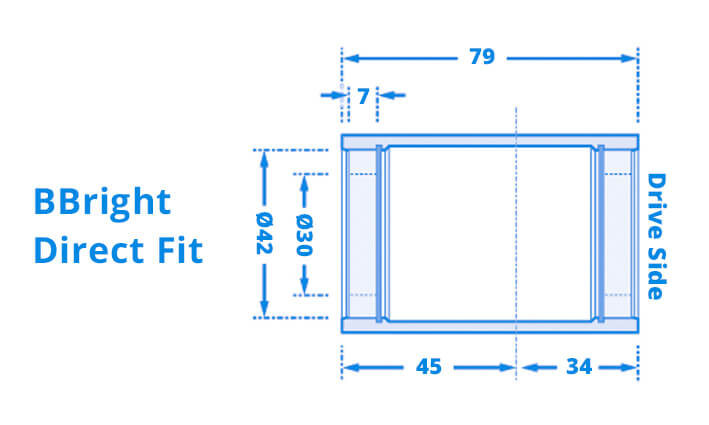
BBright Direct Fit is 79mm wide and has 42mm diameter. BBright Press Fit is also 79mm wide, but the diameter is 46mm.
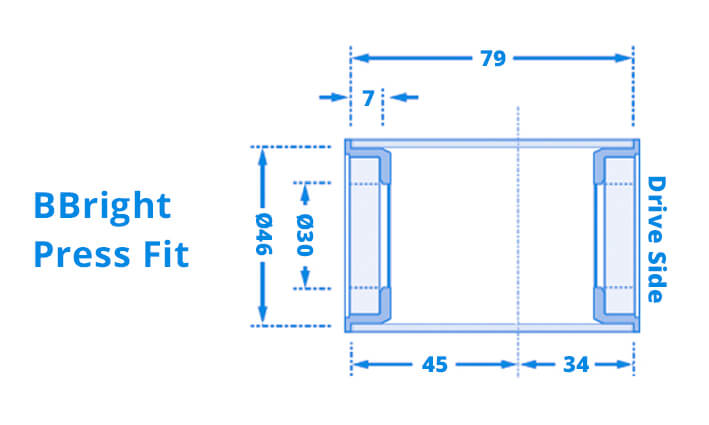
The obvious difference to other bottom brackets is that BBright bottom brackets are very asymmetric. Thee non-drive side is much wider and the wheel isn’t positioned in the centre of the bottom bracket. This is said to provide extra stiffness.
Which cranks fit onto a BBright bottom bracket?
- Shimano Hollowtech II
- Rotor 3D+
- Sram GXP
- FSA Megaexo
- BB386EVO
- Campagnolo Ultra Torque and Power Torque
BB90\BB95
BB90 is the bottom bracket standard used by Trek. You see BB90 on road bikes. The diameter is 37mm and the width is 90,5mm.
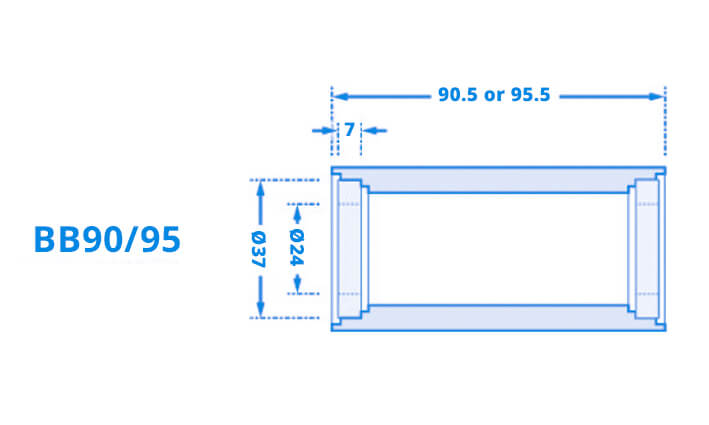
On mountain bikes the BB95 version is used. It also has 37mm diameter, but with 95,5mm it’s significantly wider.
Which cranks fit onto a BB90/BB95 bottom bracket?
- Shimano Hollowtech II
- Sram GXP
- Campagnolo Ultra Torque and Power Torque
BB386EVO
The last bottom bracket standard in this list is BB386EVO. It has been developed by FSA and is said to ‘combine the best of both worlds’. The bottom bracket is 86.5mm wide and has a diameter of 46mm.
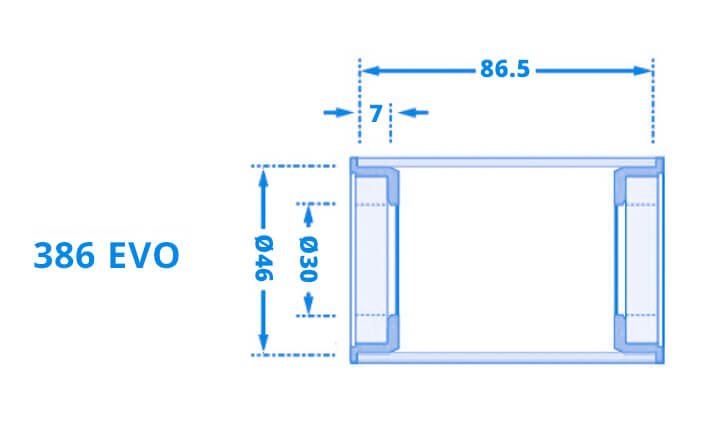
It thus is a combination of the popular stiffness of a 30mm spindle and the stiffness of an 86.5mm bottom bracket.
The external characteristics are limited to a narrow plastic edge. Luckily most manufacturers using this standard put a sticker on the frame.
Which cranks fit onto a BB386EVO bottom bracket?
- Shimano Hollowtech II
- Rotor 3D+
- Sram GXP
- FSA Megaexo
- BB386EVO
- Campagnolo Ultra Torque and Power Torque
What bottom bracket bearings go with my bottom bracket shell?
Now that you know which bottom bracket shell your frame has, it is easy to have a look at the bottom bracket bearings that are compatible with your bottom bracket shell.
Which bottom bracket bearings you choose depends on the type of bottom bracket shell and the crankset that you use or want to use. Because almost all the manufacturers have their own bottom bracket bearings, we split them by manufacturer.
Shimano bottom bracket bearings
Shimano uses Hollowtech II spindles for their cranks. These spindles have a diameter of 24mm. Do you have a Shimano crank and do you know which type of bottom bracket shell your frame has? Have a look below to see which bottom bracket bearings you need.

Campagnolo bottom bracket bearings
Campagnolo has two different types of cranksets: Ultra-Torque and Power-Torque.
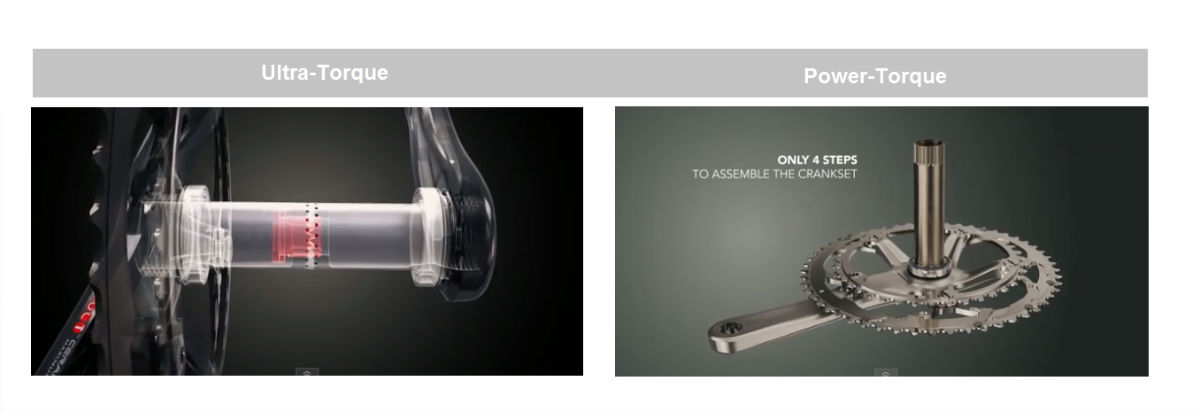
On an Ultra-Torque crankset each crank arm has a spindle attached to it, and a bearing is pressed onto each crank arm/spindle. The bottom bracket bearings thus consist of a shell, without the actual bearings, that is screwed into the frame.

A Power-Torque crankset has a one-piece spindle. On the right crank arm (drive side) a bearing is pressed onto the crank. The bottom bracket bearings consist of one shell without bearings (drive side) and one shell with bearings (non-drive side).
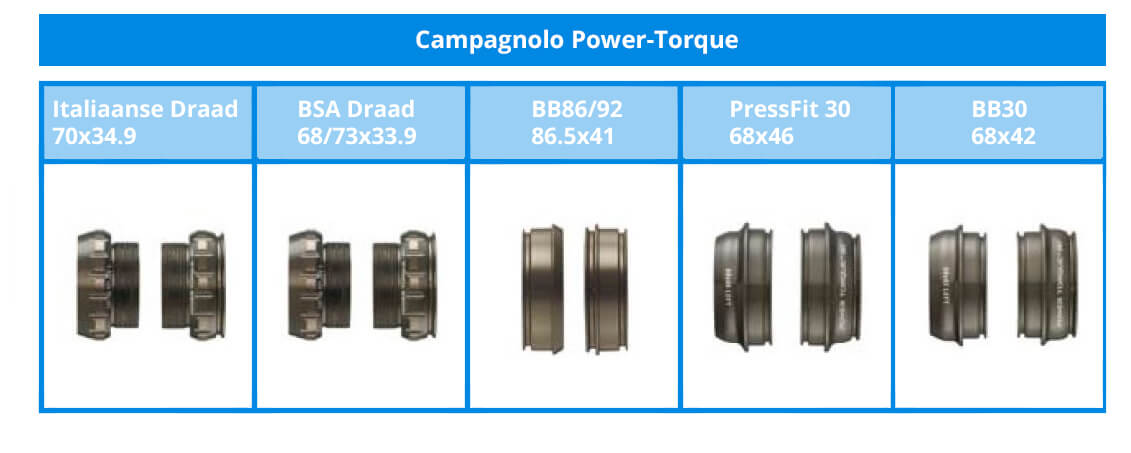
SRAM bottom bracket bearings
SRAM cranks come in two different versions: GXP and BB30. SRAM GXP cranks have a spindle with 24mm diameter on the drive side and 22mm on the non-drive side. Using a GXP crank means that you also have to use GXP (compatible) bottom bracket bearings.
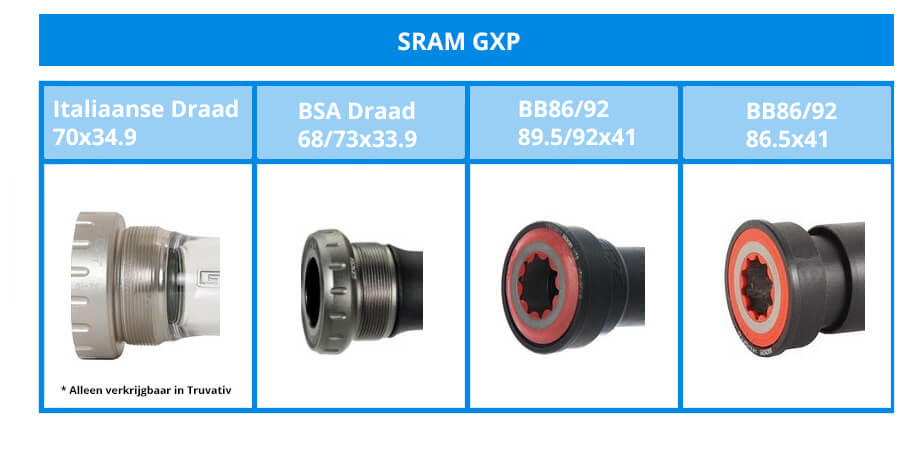
Besides these, SRAM also has BB30 cranks with a 30mm spindle. These cranks can be used with BB30 or PF30 bottom bracket bearings.

FSA bottom bracket bearings
FSA distinguishes four types of cranksets: BB386 Evo, Mega Exo, BB30 and Mega Exo 19mm cranks. Especially the Mega Exo cranksets are quite common.
BB386 cranksets have a spindle with a diameter of 30 mm and a length of 103.8mm.
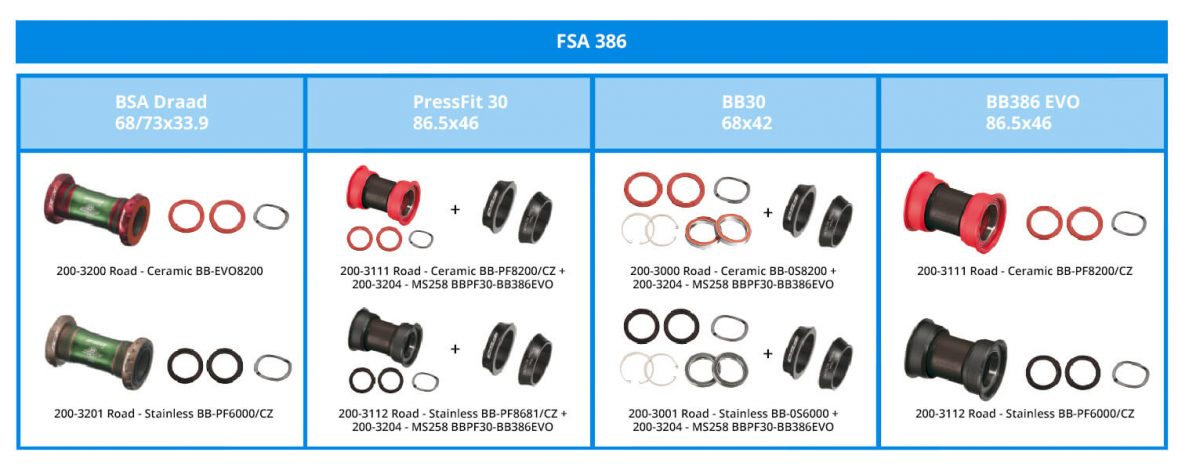
Mega Exo cranksets have a spindle diameter of 23,5 mm and a length of 103.8mm

FSA’s BB30 cranksets have a spindle with 30mm diameter and a length of 84.2mm
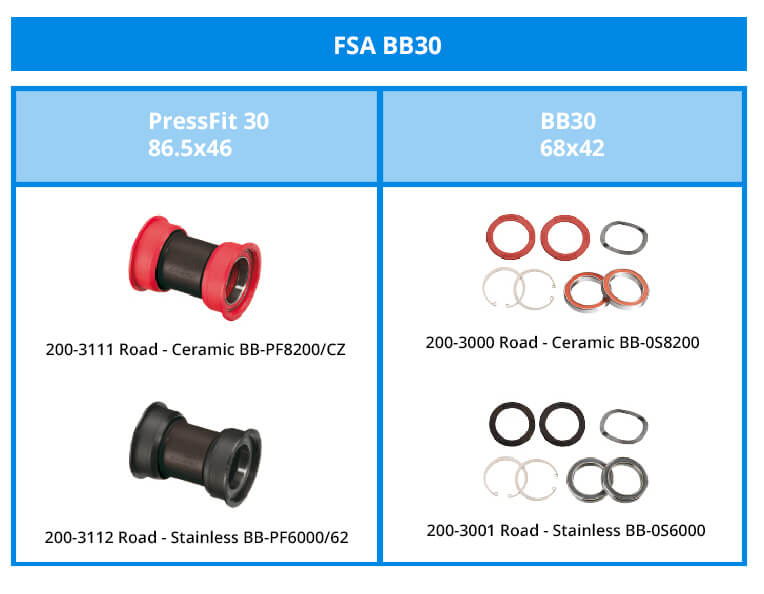
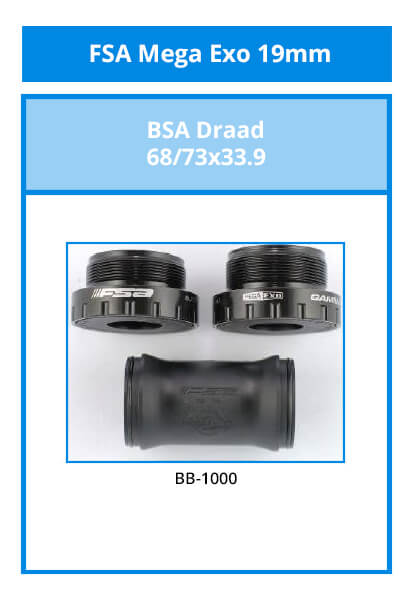
Mega Exo 19 mm – FSA also offers cranksets for road bikes and mountain bikes that have a spindle with a diameter of 19 mm.
For road bikes, this type is called Omega. The mountain bike version of these cranks is called Comet and V-Drive.
Rotor bottom bracket bearings
Rotor offers a range of several different cranks. One of them are the 3DF cranks with a spindle diameter of 30mm. These can be used in almost all frames, also with a BSA bottom bracket. The difference in width is filled up by placing a special tube. This series also uses UBB30 bottom bracket bearings.
Another type of Rotor cranks is the 3D crank which has a spindle with 24 mm diameter, the same as Shimano Hollowtech II.
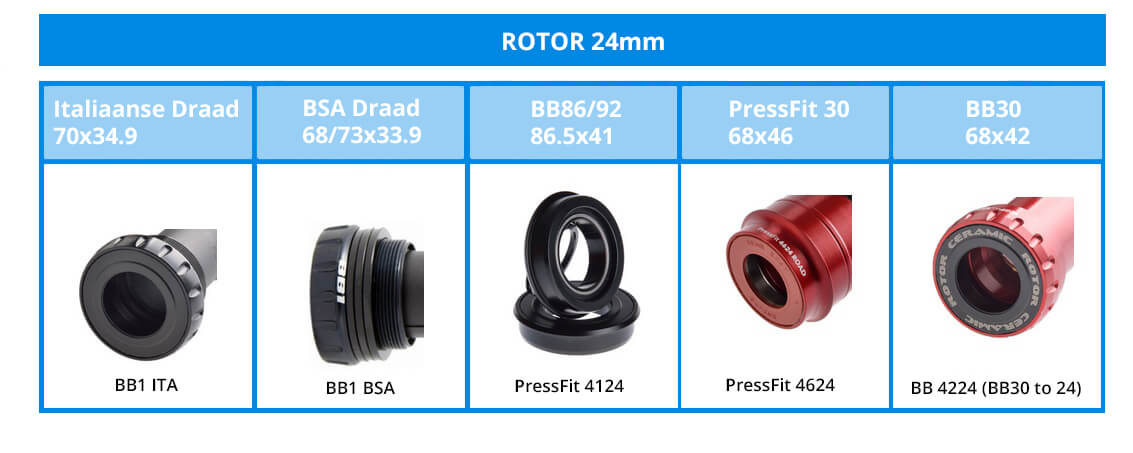
The last type of crank Rotor offers is the 3D+ crankset. The spindle diameter is 30 mm. Thus a 3D+ crank is a lighter and also more expensive version of the 3DF cranks.

For the sake of completeness, this is the compatibility table from Rotor itself.
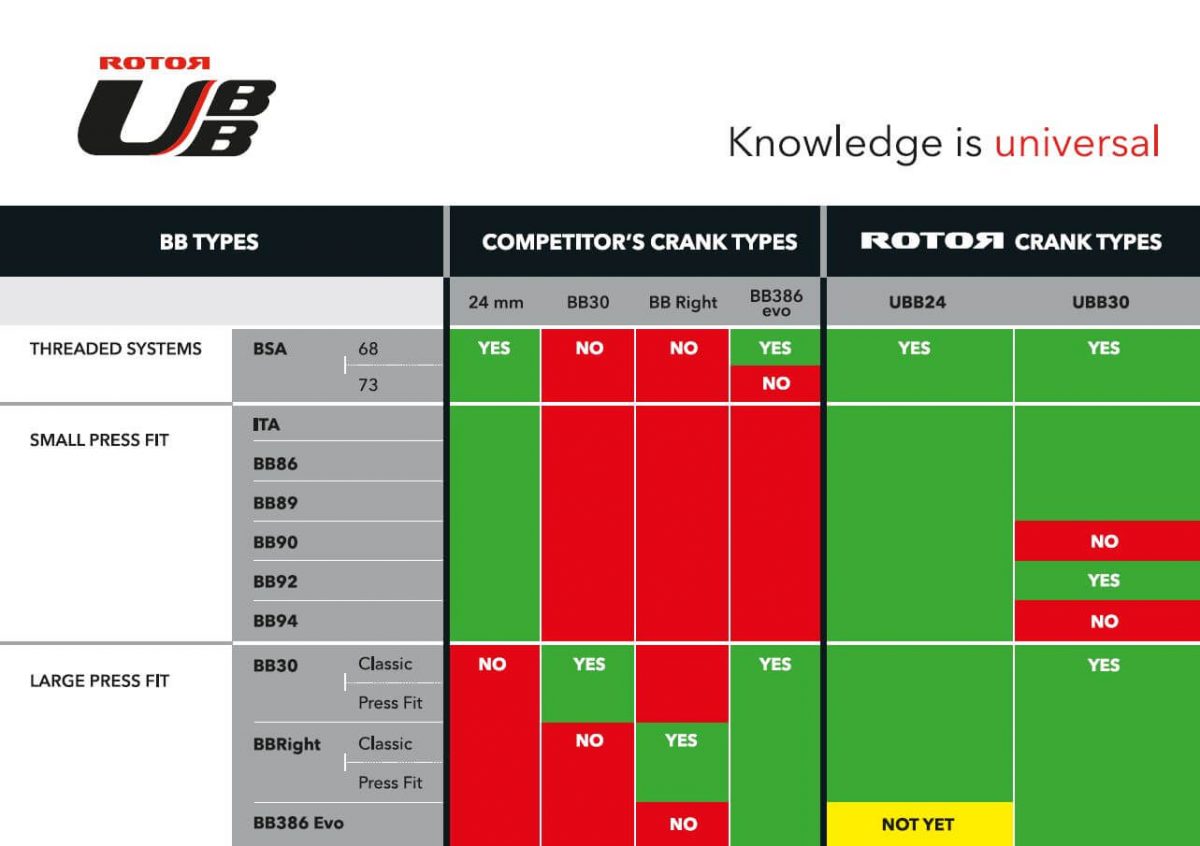
Converters and adapters for bottom bracket shells, bearings, and cranks
Coming to a major question: Is it possible to combine the different standards? The good news is: yes, it’s possible. But not always. Below you find an overview with the current possibilities with converters and adapters for bottom bracket shells and bearings.
From BB30 or PF30 to another standard
You have to press the tubes pictured below into your existing bottom bracket bearings.

When you have pressed this tube into your bottom bracket bearings, you’ll have kind of a double bearing. This is normal, although it looks unusual at first.
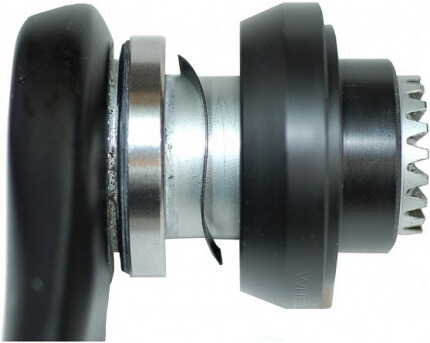
Please take into account that a threaded adapter is not without risk. It seems to be a good option at first, but keep in mind that the tube has to be pressed in with loctite. That’s something that should only be attempted by experienced bike mechanics.
The risk of a threaded adapter is a higher likelihood of creaking, and it can even be a reason for forfeiture of the frame guarantee. So be sure to inform yourself or ask your frame’s manufacturer if the guarantee remains valid if you choose this conversion.
Rotor adapters are currently the best solution for a BB30 conversion. Screwing the two parts together – or, in case of a PressFit 30 bottom bracket shell, pressing them in – is the safest conversion.
From BSA to BB30
Currently it’s possible to benefit from the stiffness of a BB30 Rotor crankset in a frame with a threaded BSA bottom bracket shell.

Rotor has developed bottom bracket bearings for this purpose which can be screwed into the threaded bottom bracket shell so that you can ride with a Rotor BB30 crankset. But take into account that you should only attempt this conversion if you use or want to use a Rotor crankset. That’s because Rotor uses a longer crank spindle for their cranksets than other manufacturers do.
Questions about bottom bracket shells, bottom bracket bearings or cranksets?
Do you still have questions after reading this guide on bottom brackets? The Mantel customer service is happy to help you with choosing the right bottom bracket bearings, crankset or bottom bracket shell.
Best BB review ever. Great stuff.
This great article was found through Google Images that the way that I follow to find a great article among good articles as pictures do speak more specially when its related to cycling that lot more engineering stuffs involved.CHEERS
I have a unkown bike co . Singularity is the frame model bb b1.37mm 68mm.the problem is i have a fsa slk light crank arm that the drive side is off by 1/2 inch i think im trying to put on but dont knw which bottom bracket i can get for me. I need help with it please.
Thank you for this great article! This is very helpful in working through the chaos of bottom bracket compatibility.
What bottom bracket shell fits the gt idrive four 1.0? It has to have the threaded hole for the flexbone bolt!
I have a FSA Gossamer crank
A3138-120.9 L
BB386EVO
0609S 2717 JBA
I have a fsa part number 200+3201
bottom bracket that the bearing is just slightly too small for the crank spindle. What am I missing? The bike stores tell me this is the correct bottom bracket. Help! I want to ride my bike…
>Mega Exo cranksets have a spindle diameter of 23,5 mm
You are reporting that the spindle diameter of FSA Gossamer (pre-2014) is 23.5 where everywhere on marketing reports it is called a 24mm.
If both Hollowtech II and Mega-Exo are 24mm why not use the Gollowtech BB that lists for $20 instead of FSA’s BB6000 that lists for $50?
It is a rhetorical question but on “How-To” cideos one guy is seen hammering the FSA into the hollowtech after grqasing the spindle and also claiming it was next to impossible to take it off. This means that it is larger than Shimano’s Hollotexh spindle, which also is claimed to be 24mm.
If it was 23.5 on a 24mm inner diameter bearing it would have been very loose and having as much play as a broken BB. Something like 23.96 on a 24mm bearing sounds right but .5mm in bearing diameter fitting sounds tremendous.
So the question is what are the “exact” diameters of spindle and bearing of Mega-Exo and Hollotech-II
I don’t have access to them all but I am willing to bet I can get Hollowtech cups and fit the appropriate size bearing into them for the Mega-Exo spindle.
The best how-to on the topic in the whole world wide web and beyond… even in the physical world or the word of mouth. Well explained.
My dream article! Pinned for the rest of my biking life
Hi Ollnot a bad job. But please stop perpetuating the “BSA” error. Birmingham Small Arms bicycle company did not give a name a bb style. You are referring to British Standard Cycle bottom brackets, BSC, which was adopted by ISO. Refer to St Sheldon.
Also thee was a world before about 1985 where bbs were usually not a single cartridge. They were a cup and cone style, adjustable with loose balls. The best ones were a very high grade.
Man, reading what you wrote about your job, i felt like nudging you out and take your place! Of course course this is just wishful thinking. You’re a damn good writer and im still have several mountains to climb to reac your level.
Well, thus is my way if saying i liked your article… And still like your job more! Happy living, man!
Man, reading what you wrote about your job, i felt like nudging you out of your position and take your place! Of course, this is just wishful thinking. You’re a damn good writer and i still have several mountains to climb to reach your level.
Well, this is my way of saying i liked your article… and still like your job even more! Happy living, man!
I’ve got a ion cx Trek with a bb86 and I want to convert it to receive bsa threaded bearing , wich adapter I should use ? Thks .
Hello. I have a bb386 frame that i put a pf30 bearing + cup in. Is it possible to use a shimano hollowtech crankset now in the pf30 bearing? If i use adapters
No mention of Sram Dub or is this article older than that?
I need a bottom bracket cartridge for a 1992 Trek 2300. I think I need the BB-UN55, 68mm, but I don’t know what width I need (the BB shell measures 68mm)
Yes, this article was very helpful to my bottom bracket conversion kit i installed onto my 24 inch kids bicycle and then installed a Shimano FX 11 speed double crank set and it works great with a 11 speed gold cassette in the rear and a 11 speed derailleur installed in the rear and a gold 11 speed chain and a front shift also that works and shifts gears up front, so i have a good running 24 inch old school kids bicycle and it is working great. TY
I am trying to find the diminutions of an FP-B602 BB but having a hard time finding them . Can anyone help me out ? Thx.
Very good article and very much needed! Thanks
There is a Headset in your picture of different BB’s though. Cane creek, shame they don’t make BB’s bet they’d be good.
Hi there,
I want to fit Shimano ultergra (advertised with BBR60 bottom bracket) to a frame shell PF30. Ho do do I go about to fit the Ultergra set to the PF30 frame shell?
Kindest regards
What adaptor do I need to fit a 24mm FSA/Wilier chainset to a Mekk Poggio P20. shell is pressfit 41 x 68.
Good article. One addition I might mention is American eccentric or Niner eccentric. These seem to be quite popular on cruiser frames.
Oh my God thank you. I have been trying to find out which cranks can work with my bb86 road bike bb. There is so much convoluted stuff online, but this article is so wonderfully illuminating.
Have rotor ardhu track cranck with 30mm axle. Any ideas of an italian track bb to fit as cannot find anything. No rotor bbs advertised. Thanks
You are a genius, Olle…
Dankie. .
hi i have one old bike with DA9000 with shimano hollowtech hub on regular specialized allez alumimnum frame
now i got a carbon trek bike with bb30 bottom bracket fixed to the frame and FSA Energy cranks on it.
My question is can i just simply swap the cranks to one another without replacing sa Bottom brackets?
I have Kestrel Legend 2014 with 105 set. The shell have (Oval Concepts) BB30 threaded adapter. I would like to know if I will be able to use the same adapter to install FSA BB386 BSA (30MM) BB?
Thank you,
I have a frame where the bottom bracket stripped the threads in the frame. Original bracket was a BB-UN55. Now that it’s stripped, what can I do? Is there a press fit that can solve my problem?
Is there an adapter that will allow a 24mm man crank set to be fitted to a American bb shell
hi, I have a quarq riken R ( i think) carbon power meter I am tring to fit. the drive side appears to be 24mm. the non drive said is different. A 24 mm bearing is too loose, a 22mm wont fit. is there a 23mm? I have read it may be 22.2. Any information would be gratefully received
I want to reduce the Q factor on my fatbike, which currently has a threaded BSA shell (external bearings). Knowing that the external cup bearings/spindle length add Q factor, is there a product on the market that converts FROM BSA (external bearings) to Pressfit? NOT Pressfit to BSA (seems that there are products for this conversion). Example may be a threaded cap with internal bearings. My only other option would be to get a narrower square taper and convert the crankset too….uggh.
Thanks
Hello, Great info here!
Do you know of a way to convert a Trek Full Stache bottom bracket (pf92) to a BSA ?
Thank you,
Jeff
Very good article, although you need to update it with SRAM’s DUB standard which is an innovative concept “one crank fits all frames”
What a great article you wrote and really great diagrams. This article will be my reference. But one thing I don’t understand: I’ve seen in multiple places that the BSA Bracket is between 33.6. and 33.9, when the diameter of the thread is bigger: 1.37 inch which is (34.789mm). I would love to see a diagram of those two numbers. I guess that the 33.6 or 33.9 is the inner diameter of the BSA bracket before threads are cut, and that the threads are cut into that diameter, such that the bottom of the threads is deep enough to take the 34.789 mm threads. So the thread slots are 1.1mm deep (34.7-33.6). Is that right?
Below is your statement:
A BSA bottom bracket can also be recognised by the writing on the bracket itself. The bearings denote: 1.37 * 24. This means that the diameter of the thread is 1.37 inch and that it turns 24 times per inch. The diameter of a BSA bracket is between 33.6 and 33.9 mm.
I have an old Rocky Mountain Instinct ( build around 2000) with a Shimano BB 1.37 x 73 and a triple crank. I would like to up grade the BB to a outboard BB and to a double crank. Would would be some of the best options for exchange. Love the bike( it cost me $50 ) and all I really needed was a rear derailleur. I just want to ride 5-6 days and around 30-45 miles at a time like I did on my road bike. Had to ditch my road bike due to being run into by a car and the wife gives me the stare every time I look at my road bike. Any input would be greatly appreciated on my quest. Thanks
Hi Olle
Please ,help me!
I’m lost between letters and numbers.
now buying Pinarello Dogma F12 frameset, I want to build a road bike. You can buy several types of bearing housings. I don’t know yet, but I want to add an 11 or 12 speed shimano Di set. What should the bottom bracket look like? BB30 or BB68? It will be a likely shimano Ultegra R8000 groupset. Or should I buy the groupset first and then the frame? I’m clueless
Thank’s
Robert
I have a unkown bike co . Singularity is the frame model bb b1.37mm 68mm.the problem is i have a fsa slk light crank arm that the drive side is off by 1/2 inch i think im trying to put on but dont knw which bottom bracket i can get for me. I need help with it please.
Hi there, you’ll need a washer: https://www.mantel.com/spareparts
Best regards,
Mantel
Great BB review. I have a Speciliaized EPIC Expert Carbon World Cup MTB 2015 with “Pressfit 30 L (68-92) >PA+GF<" bottom bracket and SRAM XX1 Eagle – 32t, 175mm non boost crank. Would the Stages Cycling POWER G3 L CARBON SRAM GXP MTB CRANK ARM be compatible.
Hi Andy,
The PA+GF is a GXP variant.
For this you can use the following Stages:
https://www.mantel.com/stages-sram-gxp-mtb-gen-3-powermeter
Its still dependant on the frame clearance if it will fit though!
See the information about the room needed for the power meter.
Have an old 1986 mountain bike with old style loose bearings in cup , How many bearings do I need in each bearing cup? Thanks
Have 1986 mountain bike old style bottom bracket with loose bearings. Can you tell me how many bearings I need in each bearing cup?
Hi Mary, sorry to say we do not have that information, it differs per type!
Best to have it looked at locally, kind regards Mantel
One thing I don’t see mentioned on *any* bottom bracket guide is the width of the bearings themselves!
For example, I have a 68mm BB and a Samox crank meant for 73mm BB, but accidentally got a Rotor BB. You’d think this should mean I’d need 5mm of spacers, but the gap is like 9.88mm.
I didn’t understand that you (apparently generally?) need to match BB brands with crank brands, which makes it difficult with uncommon brands. And no sites seem to describe the bearing width of the BB itself, to help plan what spacers will be needed.
One site I found measured the total width of their BB when installed in a 68mm bracket (I forget the edge-to-edge name they used), which was helpful, but otherwise adapting one brand to another is confusing.
I find it surprising that your guide even covers adapting one *type* of BB to another, but not dealing with differing widths of the bearing units themselves.
Hello, I have one confusion over BBs.
For Shimano road crank spindles of either 68 or 70mm long, intuitively I understand that they fit for BB’s that have 68mm wide shells. What is confusing for me, I am looking at newer bikes with BB86 BBs that have road shells that are 86.5mm wide. Are Shimano GRX crank spindle of 68 or 70mm long enough to work in a BB shell of 86.5mm? What am I missing??
TS
Hi TS,
The crank spindles are long enough for the broader frame and BB. However for real small ones one can use spacers or other implants to make it work.
All the best!
A very comprehensive and easy to understand guide on BB combos. So useful and detailed where necessary. BBs can be a tricky business but thanks to this beauty, it’s now pretty straightforward. Thank you.
Good to hear that you succeeded
Is the rotor axle bearing 46 to 30 compatible with pressfit frame 86.5 x 41 mm ?
Thanks
Hi Pierre,
Assuming you mean the Rotor PressFit 4630 bottom bracket, I’m afraid it won’t be compatible. The bottom bracket has a shell width of 46mm and will therefore not fit the 41 shell width of the frame.
Cheers, Pelle|Mantel
I used the Shimano BB-UN55 (68mmx127.5mm) to replace an old ball bearing bottom bracket. Easy to install and glad I got it. Highly recommended to upgrade your current crap bike’s bottom bracket.
Hi Robert,
Glad to hear your upgrade was successful! Thanks for sharing your experience with us.
Kind regards,
Pelle | Mantel